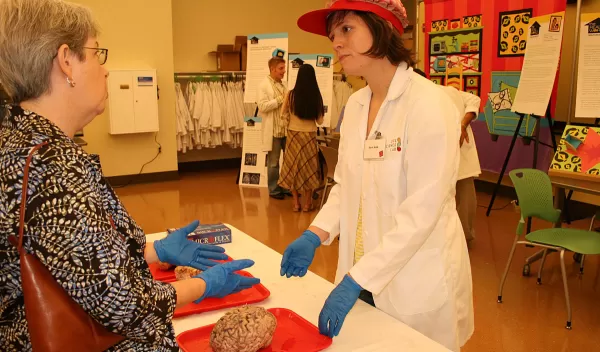
How Jellybeans Can Reveal Neuroscience to the Public
Studying brain science in the 21st century requires crossing traditional boundaries, and with that comes the need for an interdisciplinary approach.
The fields of psychology, neurobiology and biomedical engineering all approach research questions from different perspectives, each with a unique way of trying to understand how the brain works. Neuroscientists of the future should be able to integrate these differences to build new and better solutions.
For example, the problem of how a person moves around in the world could be approached by examining the mechanics of how her arm reaches for a target--an engineering problem. Alternatively, this question could be examined in healthy adults compared to those who have a particular disease that affects movement, like Parkinson's, which may clarify how the brain works differently when damaged--a neurobiological question. Finally, a brain scientist could study how the brain makes decisions about movements in response to a disturbance, like an opposing force--from the standpoint of a cognitive psychologist.
Ideally, cutting-edge neuroscience would draw expertise from more than one of these fields to answer hot topic questions about the brain.
Minding what you say
Many graduate students find that discussing their research in this sort of detail with other scientists both in and out of their fields can be a bit nerve racking.
Now imagine trying to talk about neuroscience research with people who may have little background in the subject--like your parents, friends, children or someone who walks in the door at your local science center--and getting them to understand and appreciate it.
Recently, I partnered with seven of my fellow graduate students to establish a novel program that trains neuroscientists to communicate with the public.
As part of the Cognitive, Computational and Systems Neuroscience (CCSN) pathway at Washington University, funded in part by a National Science Foundation (NSF) Integrative Graduate Education and Research Traineeship (IGERT) program grant, we worked with staff from the Saint Louis Science Center (SLSC) to create a science communication course targeted towards audiences with little understanding of neuroscience.
Graduate students in neuroscience, psychology and biomedical engineering programs were invited to participate, and, in the first year, eight students attended three professional development workshops taught by Science Center staff.
"The Real World - Neuroscience"
The curriculum focused on the audience and included presentation language and tools for creating demonstrations and exhibits about our research lives and discoveries. Out of these workshops emerged an event highlighting brain research that debuted last October during SciFest08. The annual Science Center festival brought nationally and internationally renowned scientists to present their research to the public, and we later repeated the effort as part of the Science Center's annual NeuroDay event during national Brain Awareness Week in March 2009.
"The Real World - Neuroscience" featured our stories of research at Washington University and our lives in St. Louis. As visitors entered the exhibit, they saw a behind-the-scenes video which followed each of us around a lab with commentary about what it means to be a scientist.
Inside the exhibit, we led hands-on demonstrations that introduced neuroscience concepts in fun and engaging ways. For example, one student, Hannah Arnson, who studies olfaction (our sense of smell), used jelly beans to show participants how olfactory sense is an important part of the experience of taste.
While our tongues sense only five distinct flavors, we have thousands of olfactory receptors in our nose, which can be activated by odor chemicals in the foods we eat. By eating jelly beans with their noses pinched closed and then again with their noses open, participants literally tasted the difference olfaction makes! This demonstration enabled Arnson to then discuss aspects of her research on olfactory coding.
Other demonstrations had graduate student experts leading visitors to monitor the electrical signals generated by their own eye movements, to train a virtual rat using classical conditioning, to examine healthy and diseased human brain specimens, and to learn how our internal clocks cope with jetlag.
It's all about perception
I was often struck by the enthusiasm of visitors wanting to know more about brain science and by their curiosity about what scientists are really like. Any perceived barriers in understanding were not ones of motivation or interest, but rather those associated with jargon.
Comments from visitors like "I had no idea research could be fun" or "I'd like to do that," plus insightful questions about our work on the brain, gave us confidence that we had effectively shared our story. By learning to speak with our audience, we conveyed our neuroscience research and enthusiasm for discovery without "dumbing down" the content. Communication is an important and often overlooked aspect of being a successful scientist.
We plan to continue this training program, with 13 new graduate students enrolled this summer. We have already been invited to present our "Real World" at several events in 2009.
I believe that by working with the Science Center and its visitors, we have gained both an appreciation for the time and effort that goes into engaging the public in scientific research and also the knowledge that engagement is a worthwhile pursuit that improves people's understanding and support of our work.
-- Alexis B. Webb, Washington University in St. Louis abwebb@artsci.wustl.edu
This Behind the Scenes article was provided to LiveScience in partnership with the National Science Foundation.


